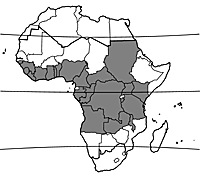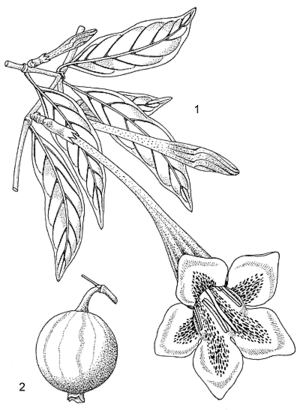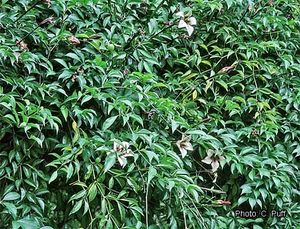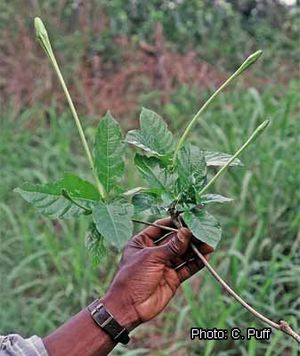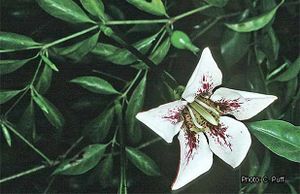Rothmannia longiflora (PROTA)
Introduction |
| General importance | |
| Geographic coverage Africa | |
| Geographic coverage World | |
| Fruit | |
| Dye / tannin | |
| Medicinal | |
| Timber | |
| Ornamental | |
| Food security | |
Rothmannia longiflora Salisb.
- Protologue: Parad. lond., 1(2): t. 65 (1807).
- Family: Rubiaceae
Synonyms
- Randia maculata DC. (1830).
Origin and geographic distribution
Rothmannia longiflora is found from Gambia east to Sudan and Kenya, and south to Tanzania and Angola.
Uses
The fruits of Rothmannia longiflora are commonly used to make blue-black markings on the hands, face and body, sometimes to imitate tattooing. In Central and East Africa fibres of vegetable origin (e.g. of Raphia) are coloured by soaking them in swamp mud to which fruits and leaves of Rothmannia longiflora have been added. In Nigeria a dye and an ink-like extract (‘katambiri’) is made from finely crushed seeds. To make a stronger dye and ink, the extract is sometimes mixed with leaves of Gardenia, Indigofera, Nauclea or Vitex and sugar or honey. A black dye can be prepared from the flowers.
The fruits are edible. In Sierra Leone the stems are used to make shafts of a long-handled chisel (‘sundi’) used for harvesting fruit bunches of oil palm and elsewhere to make spear handles. In Ghana twigs are used as chewsticks. Rothmannia longiflora is considered to have febrifugal and analgesic properties, and a decoction of the leaves, twigs, bark and roots is applied internally or externally in lotions, washes and baths. In Nigeria the roots are used to treat bowel complaints. In DR Congo a root infusion is applied as a treatment for throat abscesses, toothache and leprosy. In West Africa leaf pulp is used as an enema against kidney pain and diarrhoea with blood, and drinking the leaf juice is said to help during labour and childbirth. In Sierra Leone leaves are used to treat itching skin diseases and the fruit pulp is said to be emetic. In DR Congo the seed is used to treat ulcers. Rothmannia longiflora is a decorative plant with large, attractive, trumpet-shaped, white or pink flowers and is worth cultivating as an ornamental.
Production and international trade
Rothmannia longiflora is collected from the wild and is traded only locally. On markets the fruits are often traded with the rind removed or as broken pieces with adhering seeds.
Properties
No specific chemical study of the colorants or dye-precursors present in the flowers, fruits or leaves is available for Rothmannia longiflora. From the fruits, branches and leaves however, 4-oxonicotinamide-1-(1’-β-D-ribofuranoside) has been isolated. This N-glycoside is only known from human urine and has never been isolated from other higher plants. It is an interesting compound, particularly in influencing enzymatic processes. The fruits also contain monomethyl fumarate (used to treat psoriasis) and D-mannitol which is used as a nutrient, dietary supplement and a texturizing agent. Due to its low hygroscopicity, D-mannitol is often used as a dusting powder to protect products against moisture pick-up. A major use of D-mannitol is in chewing gum and it is also widely used in intestinal permeability tests.
Description
- Shrub or small tree up to 9 m tall, often with climbing stems.
- Leaves opposite, simple and entire, glabrous; stipules triangular, c. 3 mm long, early caducous; petiole 3–10 mm long; blade elliptical, 6–18 cm × 2–8 cm, base cuneate, apex acuminate, pinnately veined with 4–5 pairs of lateral veins having axillary domatia.
- Flowers solitary, terminal on short axillary branches, bisexual, regular, 5-merous, sweetly scented; pedicel up to 1 cm long, bearing 5–9 scale-like bracteoles; calyx tubular, 1–2 cm long, lobes triangular, 1–4 mm long; corolla trumpet-shaped, up to 24 cm × 4 cm, lobes ovate, 1–4 cm × 1–1.5 cm, purple-red to green outside, whitish with purplish spots inside; stamens inserted in the corolla tube, included or with tips of anthers exserted; ovary inferior, 2-celled, style 12–21 cm long, stigma 2-lobed, up to 3 cm long, partly exserted.
- Fruit a globose to ellipsoid berry, 3.5–7 cm × 5–6 cm, green-blackish, with 10 indistinct ribs, glabrous, many-seeded, the calyx persistent.
- Seeds lens-shaped, 6–8 mm × 5–6 mm × 1–1.5 mm, brown-red.
Other botanical information
Rothmannia comprises about 30 species, distributed in tropical Africa, Madagascar and Asia. In tropical Africa about 18 species are present.
The following Rothmannia species, also occurring in tropical Africa, have or most probably have, similar dye, medicinal and ornamental uses:
Rothmannia engleriana
Rothmannia engleriana (K.Schum.) Keay, small tree with fruits 2–5 cm long, found in Angola, DR Congo, Zambia, Malawi, Mozambique, Tanzania and Burundi; the ripe fruit is edible, it is juicy, sweet and aromatic; an infusion of the roots is used against stomachache and snakebite; the wood is used as firewood and to make tool handles and spoons.
Rothmannia fischeri
Rothmannia fischeri (K.Schum.) Bullock, shrub or small tree up to 8 m tall, fruits 3–6 cm long, found in Kenya, Tanzania, DR Congo, Malawi, Zambia, Zimbabwe and South Africa.
Rothmannia hispida
Rothmannia hispida (K.Schum.) Fagerl. (syn.: Randia hispida K.Schum.), shrub or small tree up to 10 m tall, fruits 6–11 cm long, occurring from Guinea to DR Congo; the wood on cutting and exposure to the air takes on a blue colour; in Nigeria, leaf sap and fruit juice are used to draw black designs on the body and to blacken tattoos; mixed with palm oil, they are applied on the skin against fungal infections.
Rothmannia lateriflora
Rothmannia lateriflora (K.Schum.) Keay, shrub or small tree up to 8 m tall, fruits cylindrical, 5-ribbed, up to about 6 cm × 4 cm, occurring in Cameroon, Gabon and DR Congo; among the Mongo of DR Congo, the juice of the fruit is used to blacken tattoos.
Rothmannia lujae
Rothmannia lujae (De Wild.) Keay (syn.: Randia coriacea K.Schum. ex Hutch. & Dalziel), tree up to 30 m tall, fruits 15–20 cm long, occurring from Nigeria to DR Congo; seeds are used in Nigeria to make a dye used by women for painting patterns on the skin; a bark decoction is drunk against abdominal troubles; the bark, leaf and root contain some tannin.
Rothmannia macrosiphon
Rothmannia macrosiphon (Engl.) Bridson, shrub or small tree up to 7 m tall, fruits 2–3 cm long, occurring in Kenya and Tanzania; the fruit yields a blue-black dye.
Rothmannia manganjae
Rothmannia manganjae (Hiern) Keay, shrub or small tree up to 15 m tall, fruits 2–4 cm long, occurring in Kenya, Tanzania, Mozambique, Malawi and Zimbabwe. This species closely resembles Rothmannia longiflora but has a much shorter corolla; sterile or young flowering specimens of both species are particularly hard to distinguish.
Rothmannia munsae
Rothmannia munsae (Schweinf. ex Hiern) Petit (syn.: Randia megalostigma (Wernham) Keay, Randia lane-poolei Hutch. & Dalziel), shrub or tree up to 17 m tall, fruits up to 7 cm long, occurring from Sierra Leone to Cameroon and DR Congo.
Rothmannia octomera
Rothmannia octomera (Hook.f.) Fagerl., shrub or small tree up to 2 m tall, flowers 7–8-merous, fruits subcylindrical, up to 14 cm long, occurring from Nigeria to DR Congo; in DR Congo and Nigeria, the fruit juice is used to draw black designs on the body and to blacken tattoos; pulped roots are applied against pneumo-bronchial troubles in Congo.
Rothmannia urcelliformis
Rothmannia urcelliformis (Hiern) Robijns, shrub or small tree, up to 15 m tall, fruit up to 10 cm long, widespread all over tropical Africa; in Ethiopia, in the province of Illubabor, the fruits are crushed and boiled in water to obtain a blue dye for cloth; they contain the iridoid alkaloid gardenamide A; fruits are said to be poisonous and have some molluscicidal property; powdered dry fruits are used alone or mixed into a hunting poison in Central African Republic.
Rothmannia whitfieldii
Rothmannia whitfieldii (Lindl.) Dandy (see separate treatment).
Growth and development
Fruiting of Rothmannia longiflora plants is about 3 months after flowering.
Ecology
Rothmannia longiflora is found in the undergrowth of primary as well as secondary forest, from sea-level up to 1700 m altitude.
Management
In cultivation Rothmannia longiflora can easily be propagated by seed.
Genetic resources
Rothmannia longiflora is widespread and common, and is not in danger of genetic erosion.
Prospects
Rothmannia longiflora is easy to grow and has interesting dye, medicinal and ornamental properties. More research is needed to evaluate its commercial and agricultural possibilities.
Major references
- Abbiw, D.K., 1990. Useful plants of Ghana: West African uses of wild and cultivated plants. Intermediate Technology Publications, London and Royal Botanic Gardens, Kew, Richmond, United Kingdom. 337 pp.
- Bridson, D. & Verdcourt, B., 1988. Rubiaceae (part 2). In: Polhill, R.M. (Editor). Flora of Tropical East Africa. A.A. Balkema, Rotterdam, Netherlands. pp. 415–747.
- Burkill, H.M., 1997. The useful plants of West Tropical Africa. 2nd Edition. Volume 4, Families M–R. Royal Botanic Gardens, Kew, Richmond, United Kingdom. 969 pp.
- Dalziel, J.M., 1937. The useful plants of West Tropical Africa. Crown Agents for Overseas Governments and Administrations, London, United Kingdom. 612 pp.
- Holland, J.H., 1908–1922. The useful plants of Nigeria. Bulletin of Miscellaneous Information, Additional Series 9, Royal Botanic Gardens, Kew, Richmond, United Kingdom. Part 1: 1–176 (1908); Part 2: 177–342 (1911); Part 3: 343–536 (1915); Part 4: 537–963 (1922).
- Irvine, F.R., 1961. Woody plants of Ghana, with special reference to their uses. Oxford University Press, London, United Kingdom. 868 pp.
Other references
- Beentje, H.J., 1994. Kenya trees, shrubs and lianas. National Museums of Kenya, Nairobi, Kenya. 722 pp.
- Bringmann, G., Hamm, A., Kraus, J., Ochse, M., Noureldeen, A. & Jumbam, D.N., 2001. Gardenamide A from Rothmannia urcelliformis (Rubiaceae) - isolation, absolute stereostructure, and biomimetic synthesis from genipine. European Journal of Organic Chemistry 10: 1983–1987.
- Bringmann, G., Ochse, M., Wolf, K., Kraus, J., Peters, K., Peters, E-M., Herderich, M., Aké-Assi, L. & Tayman, F.S.K., 1999. 4-Oxonicotinamide-1-(1’-beta-D-ribofuranoside) from Rothmannia longiflora Salisb. (Rubiaceae). Phytochemistry 51: 271–276.
- Hallé, N., 1970. Rubiacées (2e partie). Flore du Gabon. Volume 17. Muséum National d’Histoire Naturelle, Paris, France. 335 pp.
- Hepper, F.N. & Keay, R.W.J., 1963. Rubiaceae. In: Hepper, F.N. (Editor). Flora of West Tropical Africa. Volume 2. 2nd Edition. Crown Agents for Oversea Governments and Administrations, London, United Kingdom. pp. 104–223.
- Hulstaert, G., 1966. Notes de Botanique Mongo. Académie Royale des Sciences d’Outre-mer, Classe des Sciences Naturelles et Médicales, N.S. 15–3, Bruxelles, Belgium. 213 pp.
- Neuwinger, H.D., 1998. Afrikanische Arzneipflanzen und Jagdgifte. Chemie, Pharmakologie, Toxikologie. 2nd Edition. Wissenschaftliche Verlagsgesellschaft mbH, Stuttgart, Germany. 960 pp.
- Neuwinger, H.D., 2000. African traditional medicine: a dictionary of plant use and applications. Medpharm Scientific, Stuttgart, Germany. 589 pp.
- Ruffo, C.K., Birnie, A. & Tengnäs, B., 2002. Edible wild plants of Tanzania. Technical Handbook No 27. Regional Land Management Unit/ SIDA, Nairobi, Kenya. 766 pp.
- Sonké, B. & Simo, A.K., 1996. Révision systématique du genre Rothmannia (Rubiaceae-Gardeniae) au Cameroun. Bulletin du Jardin Botanique National de Belgique 65(1–2): 219–247.
- Tournerie, P.J.M., 1986. Colour and dye recipes of Ethiopia. Published by the author, Exeter, United Kingdom. 152 pp.
Sources of illustration
- Irvine, F.R., 1961. Woody plants of Ghana, with special reference to their uses. Oxford University Press, London, United Kingdom. 868 pp.
- Hallé, N., 1970. Rubiacées (2e partie). Flore du Gabon. Volume 17. Muséum National d’Histoire Naturelle, Paris, France. 335 pp.
Author(s)
- P.C.M. Jansen, PROTA Network Office Europe, Wageningen University, P.O. Box 341, 6700 AH Wageningen, Netherlands
Correct citation of this article
Jansen, P.C.M., 2005. Rothmannia longiflora Salisb. In: Jansen, P.C.M. & Cardon, D. (Editors). PROTA (Plant Resources of Tropical Africa / Ressources végétales de l’Afrique tropicale), Wageningen, Netherlands. Accessed 31 May 2025.
- See the Prota4U database.

